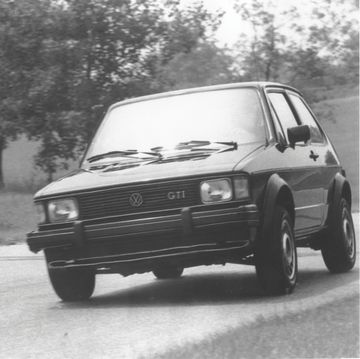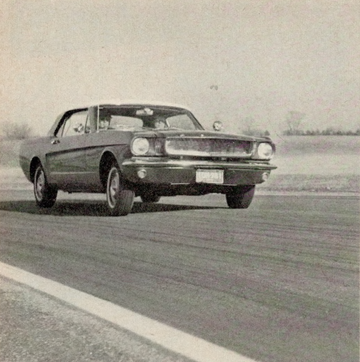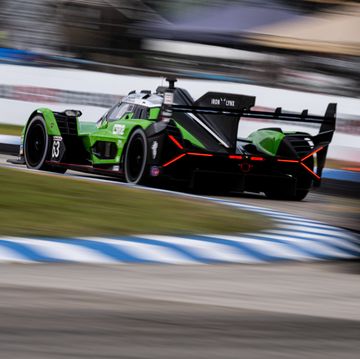OCTOBER 2014: A friend at Ford tells me to "get ready" for a car being introduced at the Los Angeles auto show the following month. He can't say anything more. The rumor is it's a new Shelby GT350 Mustang—the rebirth of a hallowed model, dead since 1970. Because I love GT350s and their history, I immediately sell my 1966 K-Code Mustang fastback to fund the purchase of a car I know nothing about, including its cost.
JANUARY 2015: Detroit auto show. The track-focused GT350R and GT supercar debut. Despite sharing minimal information about the GT350R—mostly engine and wheel details—Ford wins the show.
MAY 2015: Ford finally releases the GT350 order form. I obtain one and use it. Still no word on price, but I remain hopeful it is roughly equivalent to the value of a '66 K-Code. Meanwhile, my wife changes the locks on our house.
JULY 2015: Ford invites journalists to Michigan's Grattan Raceway for rides in preproduction GT350s. It's hot—in the 90s, with choking humidity—but I drive to Grattan from my Wisconsin home, in my unrestored 1965 GT350, because it seems like the thing to do. Short gears, side exhaust, concrete suspension, no A/C: I arrive moderately delirious, nearly melted, and mostly deaf. The new car seems sensational, but Ford's drivers are purposely lifting during hot laps to keep people from quietly recording times. I throw the keys to my car to Gene Martindale, one of the GT350's development engineers, and remind him that, unlike the new car, a stock '65 doesn't have an 8250-rpm redline. Martindale, later: "I cannot believe how hard-core this car is. They actually sold them like this?"
Exactly. An SCCA B-Production race car with a license plate. That's one of the great things about a first-year GT350—you know exactly what Shelby's guys wanted the car to be.
AUGUST 2015: The Shelby GT350 Mustang is the featured marque at the Rolex Monterey Motorsports Reunion. A new GT350 is on display, turned on its side on a giant rotisserie. I wander around it for a good half hour. The car's underside looks expensive, more Stuttgart than Detroit. Waiting is really starting to hurt.
A week after the Reunion, I was back in Monterey, at Mazda Raceway Laguna Seca, for the GT350 media drive. Finally.
WITHIN FORD, the GT350's naturally aspirated V8 is known as "Voodoo." This 5.2-liter, 526-hp, 32-valve engine is a heavy rework of the 5.0-liter "Coyote" found in the current Mustang GT. It was designed for track use, optimized for high rpm, and is found in no other Ford product right now.
The first thing you notice about the GT350 is its sound—every bit as good as those YouTube clips. This is partly thanks to the engine's 180-degree crankshaft—it features single-plane crankpins, like a modern Ferrari V8, aiding everything from header plumbing and exhaust scavenging to balance at high rpm. This is a loud, basso engine. At full throttle in the track-focused GT350R model, windows open, the car makes enough noise that two helmeted passengers can't hear each other yell. It's great.
So-called flat-crank V8s have been around for decades, but this is the first mass-production American one. Compared with a traditional Detroit V8 like the Coyote, the Voodoo doesn't have two successive firing events on the same side of the vee at 90 degrees. Without those same-side firings, the Voodoo loses the traditional American V8 burble, but you gain a snarling, guttural bellow at speed and a thrummy growl at idle, like two four-cylinders joined at the hip.
Internally, the engine is a jewel. Every component, from the gun-drilled crank and short-skirt pistons, to the 10-quart composite oil pan, was clearly engineered for a specific purpose. Examples: Ford claims 40 percent of the Coyote's internal friction comes from its piston rings, so considerable time was spent developing a low-tension ring package to reduce frictional losses. They also focused on crankcase breathing. In a standard Detroit V8, cylinders fire in alternating pairs on either side of the engine and whip oil onto the crankshaft, which consumes horsepower. A flat-crank V8 alternates firings from one bank to the other, greatly reducing windage. But Ford also added a substantial composite windage tray in the oil pan.
This may seem like minor stuff, but it's the kind of work NASCAR teams do on engines costing more than this car. And it undeniably works. The Voodoo's peak power comes at 7500 rpm, and peak torque, 429 lb-ft, hits at an impressively low 4750 rpm. (Undoubtedly thanks to the engine's variable valve timing, which controls the intake cams and their massive 14 millimeters of lift.) The power curve is absurdly flat, and the engine is astonishingly flexible. Flat-crank motors have a reputation for being peaky, but this one pulls hard, from the basement to the top floor, and never feels strained.
The transmission, a heavily revised Tremec TR3160 six-speed, sits behind a new dual-mass flywheel and a lightweight, twin-disc clutch. Ford obviously wanted a lighter and more rpm-friendly transmission than the balky yet robust TR6060 found in the last (662-hp) Shelby GT500, and the Voodoo's comparatively lower torque allows for that.
The clutch is surprisingly light, and the transmission shifts precisely, although the trade-off seems to be a slight buzziness transmitted through the shift lever. It's ever-present but not annoying. The Torsen limited-slip diff has a 3.73:1 final-drive ratio. The combined gearing seems perfect, dialed in to keep the engine above its 3500-rpm sweet spot during fast road or quick track driving, and within spitting distance of that torque peak.
Nailing the throttle and grabbing second gear on the stock (and bespoke-compound) Michelin Pilot Super Sports brings enough wheelspin to trigger traction control, even in the system's Sport mode, followed again by rubber in third. The car's engineers say the GT350 was built to be a balanced track car, but seat-of-the-pants feel suggests quarter-mile times solidly in the 12-second range.
Compared with the 5.0-liter in the base Mustang GT, or even the 444-hp version in the 2012–2013 Mustang Boss 302, the GT350 is a different animal. To say nothing of being unlike a traditional Mustang. The car has a shift light in its standard head-up display; the first time I used it, I thought it was broken. The damn engine just revs forever.
The GT350 is essentially all-new from the A-pillar forward, with flared aluminum fenders and a restyled nose and tail. The front fender vents are functional, helping extract air from the wheel wells. Even the rocker panels are vented to help remove air from under the car. The decklid is adorned with one of three spoilers: a small lip on base cars, a larger lip on track-package models, or a full-on wing on the GT350R.
Ford says a GT350 with the track package weighs about 3800 pounds, but it drives more like its 2800-pound 1965 cousin than you'd think. The new car feels light on its feet, and it doesn't do anything stupid when pavement gets rough. Ford Performance chief engineer Jamal Hameedi and his team worked particularly hard at making the front suspension "right," because, Hameedi says, once you have that on a Mustang, the rear will follow. So the GT350 gets a wider front track and aluminum front uprights in place of the standard car's cast-iron units. Adjustable magnetorheological dampers are also included in the track package and standard on the GT350R. They're so incredibly capable and versatile, they should be mandatory equipment.
On the flip side, when you aren't hooning the thing, and the adjustable steering assist, throttle response, and dampers on MagneRide cars are set to what you'd use to take Grandma to church, the GT350 is comfortable and quiet.
Finally, the brakes. Sweet baby Jesus, the brakes. If you need a reason to justify a GT350 purchase beyond that engine, they're it: 15.5-inch, pin-drive floating rotors with radially mounted Brembo six-piston monoblock calipers in front and 15.0-inch floating rotors with four-piston Brembo calipers in the rear. They are astonishingly good, race-quality or better, and unflappable on the road. Ford even engineered special "stiff" front wheel bearings to combat caliper-piston knockback, the bane of road-race brakes, in severe use.
At Laguna Seca, first up was a track package car. In Track mode, the chassis was shockingly neutral, with no crazy push like the 2015 Shelby Super Snake we recently tested ["Numbers Game," October]; no oversteer like the old live-axle, big-horsepower GT500; and zero noticeable intervention from the electronic nannies. The engine loves to spin, and even with that high torque peak, you use the gearbox a lot less than you'd think. Laguna becomes a third- and fourth-gear track.
By way of comparison, I've spent many track days in a 2012 Boss 302 Laguna Seca, the most lap-friendly Mustang to date. As fantastic as that car is, the GT350 with the track package is superior. Any good lap in the Boss requires arguing with the car, but the GT350 never complains. And there's no contest on the brakes.
Next, I climbed into the GT350R. Frankly, I was unprepared for the vast difference between the two cars. Hameedi's crew claims to have used the Porsche 911 GT3 as one of its bogies, and the Ford is rumored to have equaled the 911's lap times at a few high-profile tracks. It's a good benchmark, and behind the wheel, the Mustang feels about as quick.
There are no resonators in the GT350R's exhaust system. It's loud. And it's perfect. Before you've crossed the blend line onto the track, you feel the added grip of the R's Michelin Pilot Sport Cup 2s, which Ford claims are roughly as sticky as Hoosier R6 DOT-R racing tires, the gold standard in amateur club racing. Those nutty skins are wrapped around R-specific 19-inch carbon-fiber wheels, half an inch wider on both ends, and a set weighs 60 pounds less than equivalent aluminum wheels. [Dissected, page 114.]
Beyond the wheels and tuning, the R has stiffer springs and anti-roll bars and a larger front splitter to balance the rear wing, along with the same engine, transmission, and differential coolers found in the track package. The insides of the front wheels are also treated with a chemical barrier to protect them from heat generated during braking. This is all well and good, but the R's tech is irrelevant: On a racetrack, the thing lays down pixie dust. It's incredible.
Granted, tires are a large part of the GT350R's goodness. Sport Cup 2s aren't cheap or low-grade rubber, and that goes double when a manufacturer works with Michelin to optimize its compound for a specific car. But you couldn't get here just by hanging those tires on a regular GT350. Nowhere did the car feel unsettled or loose. It doesn't care if you run it up rumble strips, miss a turn-in, or brake far too deep. Slamming down through the Corkscrew with the inside front tire high off the ground, the Ford sticks better than most race cars, and the touchdown is uneventful. The R seems to enjoy it and feels as if it could do it all day, never getting hot, never falling off.
What do the original GT350 and the new one have in common? For starters, they both came out punching above their weight and are each pretty good at it. A base GT350 is $49,995, with another $6500 if you want the track package. The GT350R is $7000 more still. Not bad for a car that, at first blush, seems a match for a six-figure Porsche.
But chiefly, while the two Fords are vastly different in performance—the new car would undoubtedly murder the old in a direct comparison—they're connected by their critical importance to the Mustang brand. The original gave the car much-needed speed cred at a time when that genuinely mattered for sales. If it hadn't succeeded, the Mustang might have died off, a cute but unimportant footnote in history.
But the first GT350 was a giant-killer. It won championships, and along the way, made Shelby a legitimate manufacturer as much as Shelby made the Mustang a legitimate performance car. The 2016 model is impressive, and its pricing certainly earns Ford entry into the ridiculous-bargain hall of fame. Even better, the new GT350 deserves its name. It's a meticulously engineered device that somehow retains the soul of the original. Worth waiting 11 months for, but also every one of the past 50 years.
2016 Ford Mustang Shelby GT350R
- Price: $63,495
- Engine: DOHC 32-valve 5.2-liter V8
- Peak Output: 526 hp @ 7500 RPM, 429 lb-ft @ 4750 RPM
- Transmission: 6-speed manual, RWD
- L x W x H: 189.7 x 75.9 x 53.6 in
- Weight: 3650 lb
- 0–60 mph: 3.7 sec (EST)
- Top Speed: 175 mph (EST)
- On Sale: Now
1965 Ford Mustang Shelby GT350
- Price: $4584 (AS TESTED IN 1965)
- Engine: 4-barrel carbureted 4.7-liter V8
- Peak Output: 306 hp @ 6000 RPM, 329lb-ft (EST) @ 4200 RPM
- Transmission: 4-speed manual, RWD
- L x W x H: 181.6 x 68.2 x 51.2 in
- Weight: 2790 lb
- 0–60 mph: 6.8 sec
- Top Speed: 124 mph














